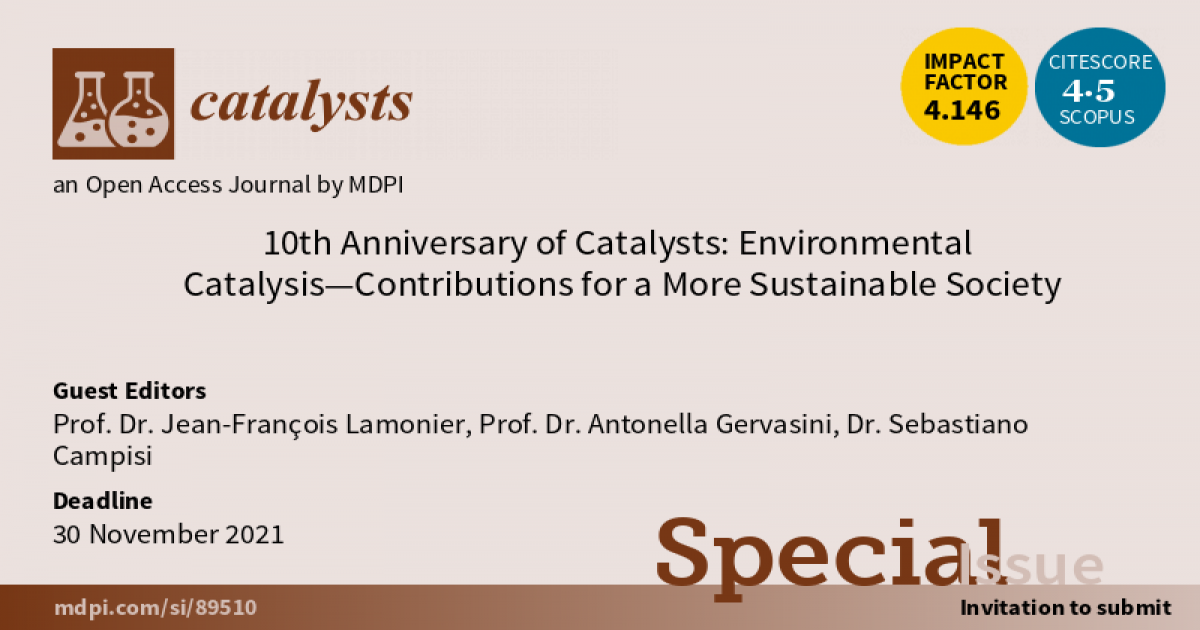10th Anniversary of Catalysts: Environmental Catalysis—Contributions for a More Sustainable Society
A special issue of Catalysts (ISSN 2073-4344). This special issue belongs to the section "Environmental Catalysis".
Deadline for manuscript submissions: closed (30 November 2021) | Viewed by 6500

Special Issue Editors
Interests: heterogeneous catalysis; environmental catalysis; VOC catalytic oxidation; plasma-catalysis; transition metal oxides; material surface characterisation
Special Issues, Collections and Topics in MDPI journals
Interests: heterogeneous catalysis; environmental catalysis; acid catalysis; solid acids; adsorption; surface properties
Special Issues, Collections and Topics in MDPI journals
Interests: heterogenous catalysis; interfaces and surfaces; material characterization; circular economy; physical chemistry
Special Issues, Collections and Topics in MDPI journals
Special Issue Information
Dear Colleagues,
Environmental catalysis is a cross-disciplinary research area combining materials design, chemical engineering, and analytical investigations with the objective of improving human health and quality of life. Environmental catalysis includes not only cleaning the air, water, and soil to remove toxic and hazardous substances, but also preventing their contamination via the production of clean fuels by developing more environmentally friendly hydrogen and syngas production technologies, greenhouse gases (CO2, CH4, N2O) reduction, waste conversion into energy and materials, etc. To meet these challenges and for a more sustainable future, new catalytic materials and technologies must be developed for the coming decades. Great challenges await us, and the expectations of the whole of society are high; it is up to the entire scientific community operating in this sector to accept the challenges and work to obtain positive results for ourselves and for our environment.
Therefore, for this Special Issue we are interested in presenting the most recent progress in the development of innovative catalytic materials and new technologies for environmental protection. Fundamental studies to establish structure–reactivity/selectivity relationships of catalysts as well as studies related to the development of advanced knowledge on emerging catalytic processes (photo-catalysis, plasma-catalysis, electro-catalysis, etc.) applied to environmental protection are welcome.
It is with great pleasure and honor that we invite you to submit a review article or original research paper for possible publication in this Special Issue celebrating the 10th anniversary of our journal.
Prof. Dr. Jean-François Lamonier
Prof. Dr. Antonella Gervasini
Dr. Sebastiano Campisi
Guest Editors
Manuscript Submission Information
Manuscripts should be submitted online at www.mdpi.com by registering and logging in to this website. Once you are registered, click here to go to the submission form. Manuscripts can be submitted until the deadline. All submissions that pass pre-check are peer-reviewed. Accepted papers will be published continuously in the journal (as soon as accepted) and will be listed together on the special issue website. Research articles, review articles as well as short communications are invited. For planned papers, a title and short abstract (about 100 words) can be sent to the Editorial Office for announcement on this website.
Submitted manuscripts should not have been published previously, nor be under consideration for publication elsewhere (except conference proceedings papers). All manuscripts are thoroughly refereed through a single-blind peer-review process. A guide for authors and other relevant information for submission of manuscripts is available on the Instructions for Authors page. Catalysts is an international peer-reviewed open access monthly journal published by MDPI.
Please visit the Instructions for Authors page before submitting a manuscript. The Article Processing Charge (APC) for publication in this open access journal is 2700 CHF (Swiss Francs). Submitted papers should be well formatted and use good English. Authors may use MDPI's English editing service prior to publication or during author revisions.







